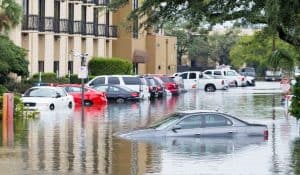 What is a hydrological disaster? Water on Earth if it experiences sudden and significant changes in quality, distribution and movement patterns can cause major natural disasters. Natural disasters caused by these conditions are usually referred to as hydrological disasters. There are at least 3 types of hydrological disasters namely floods, limnic eruptions, and tsunamis.
What is a hydrological disaster? Water on Earth if it experiences sudden and significant changes in quality, distribution and movement patterns can cause major natural disasters. Natural disasters caused by these conditions are usually referred to as hydrological disasters. There are at least 3 types of hydrological disasters namely floods, limnic eruptions, and tsunamis.
1. Flood Hydrological Disasters
Flooding refers to the overflow of water that covers (drowns) dry soil. The body of water on the surface of the Earth such as rivers or lakes may have a volume of water that varies in certain seasons, but the overflow of water referred to as flooding only occurs when overflowing water reaches the land that is used or inhabited by humans or wildlife.
Floods can occur for a long time or occur in just minutes. Floods can be classified based on the source of water, the trigger factors, and the area affected by it. Several factors can cause floodings such as heavy rain, dam damage, landslides and Earthquakes that can change the flow of river water, and tsunamis.
Large floods can cause loss of property and death of living things. For example, one of the worst floods in the last decade was a flood in China in 1931 which left 2.5 million dead and millions of animals dead.
2. Limnic Eruption Hydrology Disaster
Lime eruptions or lake lakes are hydrological natural disasters that occur due to eruptions of carbon dioxide in the waters of the lake. This natural phenomenon is a very rare thing. The sudden release of gas can produce large clouds that threaten living things around it, including humans.
Limnic eruptions occur in the lake due to the release of carbon dioxide gas. Although very rare, this eruption is categorized as a hydrological disaster. The sudden release of CO2 gas at the bottom of the lake can produce large carbon dioxide clouds that are deadly to living things. In addition, due to this eruption, it can also cause large ripples of lake water resulting in a local tsunami around the edge of the lake.
Lakes that experience eruptions like this are commonly known as “exploding lakes”. One of the deadliest limnic eruptions occurred on August 15, 1984, namely when Lake Monoun in Cameroon exploded and released carbon dioxide, killing 37 people.
Further reading:
- Deep Sea and Shallow Sea Ecosystems
- Fisheries Oceanography of The Blue Planet, Earth
- Revealing the Secret behind the Beauty of the Rainbow River Phenomenon
- Influence of the Sea on the Climate and the Symptoms it Causes
- What Happens If the Water on Earth Is Run Out?
3. Hydrological Tsunami Disaster
Tsunamis are caused by the transfer of large volumes of water both at sea and on lakes. This transfer of water produces a series of large and high waves. The causes of the tsunami were caused by Earthquakes, volcanic eruptions, the collapse of large ice blocks (glaciers), underwater gas explosions, volcanic eruptions, and landslides.
All of these events can move large amounts of water from the body of the water, resulting in what is called a tsunami. Tsunami waves can reach tens of meters or even hundreds of meters (megatsunami). Although tsunamis usually only affect coastal areas or coastlines and lakes, strong tsunamis can affect the shape of the reliefs of the seabed and lake.
The 2004 Indian Ocean Tsunami was one of the deadliest tsunamis ever recorded in this decade. The hydrological disaster was triggered by an Earthquake and killed thousands of people in 14 countries bordering the Indian Ocean. In addition to many who died, thousands of other people have not yet been found.